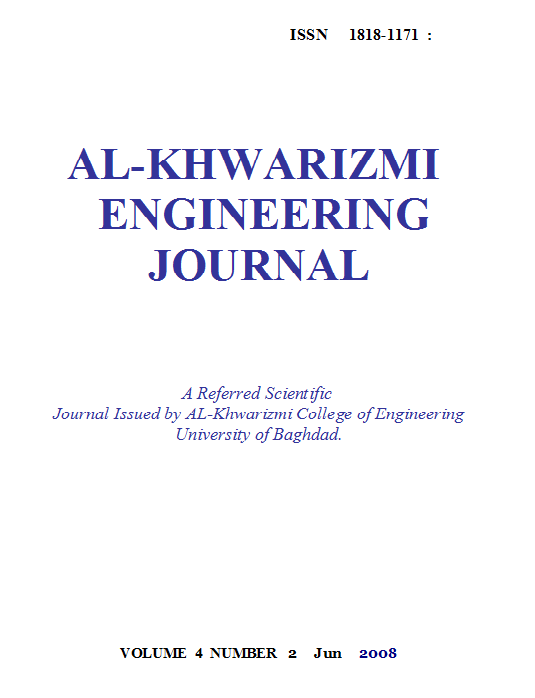Simulation of Temperature Distribution in TIG Spot Welds of (Al-Mg) Alloy Using Finite Element Method
Abstract
This research concern to analyse and simulate the temperature distribution in the spot welding joints using tungsten arc welding shielded with inert gas (TIG Spot) for the aluminum-magnesium alloy type (5052-O).
The effect of and the quantity of the heat input that enter the weld zone has been investigated welding current, welding time and arc length on temperature distribution. The finite element method (by utilizing programme ANSYS 5.4) is presented the temperature distribution in a circular weld pool and the weld pool penetration (depth of welding) through the top sheet ,across the interface into the lower sheet forming a weld spot.
A three dimensional (3-D) model has been constructed to study the temperature distribution and the depth or penetration of the weld spot. The results showed that the weld zone and heat affected zone (HAZ) suffer from high temperature variation caused by severe thermal cycle. The temperature reaches the highest value of the melt metal at the weld spot 698°C at weld current 130 Amp, weld time 6 sec and arc length 1.6 mm, then drops further away from the weld spot in the direction the base metal.
Figuers were plotted to explain the results and to show the temperature distribution and its value in the weld spot and heat effected zone.
Downloads
References
[2] Society for American Metal, Metals Handbook, Vol.6, 9th Edition, Copyright, 1983.
[3] Sindo Kou, "Welding Metallurgy", 2nd Edition, John Wiley & Sons, Inc. Publication, 2003.
[4] Justin D. Francis, "Welding Simulations of Aluminum Alloy Joints By Finite Element Analysis", MSc.Thesis, Virginia Polytechnic Institute and State university, Blacksburg ,Virginia, Apirl 2002 .
[5] Daniel Berghand, " Simulation of Welding and Stress Relief Heat Treating in the development of Aerospace Components", Licentiate Thesis, Luleal Tekniska University, 2001 .
[6] Finite Element Analysis, Theory and Application With ANSYS”, Second Moaveni, Prentice Hall, 1999.
[7] Huebner K. H. and Thornton E. A., “The Finite Element Method For Engineering” , 2nd Edition, Wiley- Intrscience, Publication, 1982.
[8] Hidekazu Murakawa and Jianxun Zhang "FEM Simulation of Spot Welding Process (Report I) – Effect of Initial Gap on Nugget Formation", Trans. JWRI, Vol.27, No.1, 1998, pp75-88.
[9] “Aluminum Select Physical and Elastic Properties”, Matter Project, The University of Liverpool, http://www.matter.com 2001
[10] 10-N.Gomesan,V.P. Rayghupathy, “Predication of Temperature Distribution During Circumferential Welding of Thin Pipes Using Finite Element Method”, Welding Journal, Vol.7(1), February ,1995, pp.34-45.
[11] Aravintton A, V.Balendron, “Modeling and Simulation of a Spot Welding Process an Overview”, Department of Computing Trent University, Burton St Nottingham http://www dcutn.ntu.com 2001.
[12] H.A. Nied, “The Finite Element Modeling of the Resistance Spot Welding Process”, Welding Journal, Vol. 63, No. 4, 1984, PP. 1235-1325.
[13] Miller Electric Mfg. Co.,"Hand Book For Resistance Spot Welding ", USA, July 2005, pp1-12. www.millerwelds.com.
[14] 14- Muna K.A. & Haitham Y. Abud-M.,"A Study Effect of Some Variables in TIG Spot Welding For (Aluminum- Magensium) Alloy".Journal of Engineering. College of Engineering, University of Baghdad, No.2,Vol.11. 2006, PP.19-30.
[15] 15- Abbass F. ," Study of TIG Spot in Al-Mn Alloy, MSc.Thesis University of Technology, 2001.
Downloads
Published
Issue
Section
License
Copyright: Open Access authors retain the copyrights of their papers, and all open access articles are distributed under the terms of the Creative Commons Attribution License, which permits unrestricted use, distribution, and reproduction in any medium, provided that the original work is properly cited. The use of general descriptive names, trade names, trademarks, and so forth in this publication, even if not specifically identified, does not imply that these names are not protected by the relevant laws and regulations. While the advice and information in this journal are believed to be true and accurate on the date of its going to press, neither the authors, the editors, nor the publisher can accept any legal responsibility for any errors or omissions that may be made. The publisher makes no warranty, express or implied, with respect to the material contained herein.












